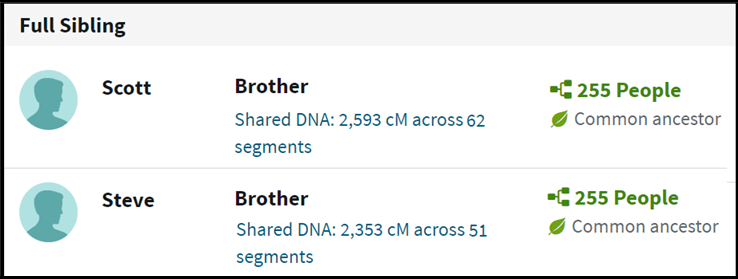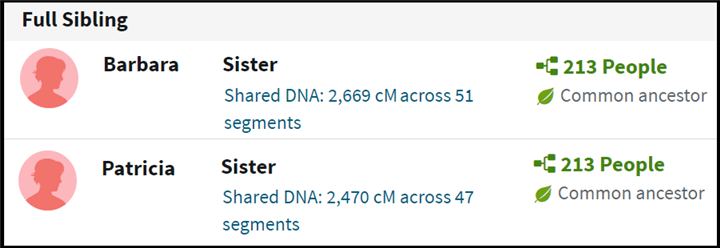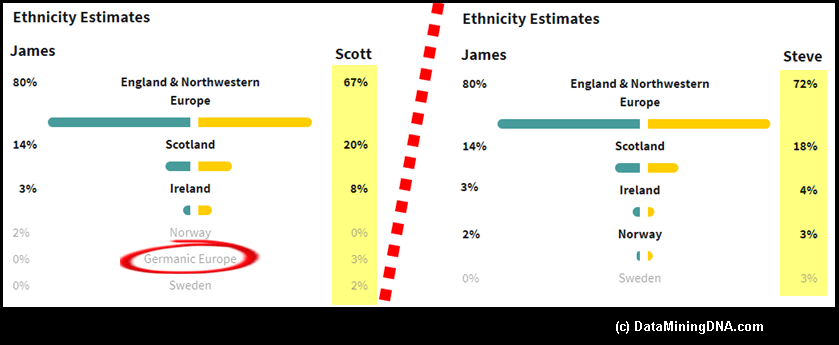This article will show you that Ancestry DNA results are not the same for siblings. Indeed, you may be surprised at the differences.
Three families who took multiple DNA tests with Ancestry.com kindly shared their results with me. This lets me show you lots of pictures from the Ancestry displays. (The tester names are altered for privacy).
Do Siblings Share The Same DNA On Ancestry.com?
I think the easiest way to answer this question is to show the amounts of shared DNA that Ancestry calculates for three siblings.
Here’s an example of three brothers who have taken the Ancestry DNA test. The brothers are James, Scott, and Steve.
This picture is an excerpt near the top of the DNA Match List display for James.

The “Full Sibling” section appears at or near the top of your display if you have a DNA match within the correct range. The section will be pushed down to second place if you have a Parent/Child DNA match.
I want to draw your attention to the number of centimorgans reported by Ancestry.
Scott shares 2,593 cM across 62 segments with James. In contrast, brother Steve shares 2,353 cM across 51 segments.
That’s a difference of 240 cM, which is enough DNA to belong to a second cousin!
A Tale Of Three Sisters
Is this a one-off? To find out, I checked with another. In this example, we’re looking at Tammy’s match list.

Tammy shares 2,669 cM with sister Barbara, while clocking in at 2,470 cM with sister Patricia.
Their shared DNA is slightly higher than the brothers in total. But there’s still a sizeable difference of about 200 cM between how much DNA that Tammy shares with one sister over another.
A picture tells a thousand words. But these don’t explain why the siblings don’t inherit the same DNA from their parents.
Why Don’t Siblings Have The Same Ancestry DNA Results?
Siblings don’t get the same Ancestry DNA results because they don’t inherit identical DNA from their parents.
James, Scott, and Steve received 50% of their DNA from each parent. But their parents didn’t give the same 50% to each child. The nature of inheritance means that the DNA gets shuffled around and recombines as it passes to the next generation.
We all share an average of 50% DNA with our siblings, but there is plenty of variation between pairs of siblings. That’s got nothing to do with Ancestry.com. It’s plain genetics.
However, the testing companies do play their part in these differences. Ancestry.com does not test and compare every snippet of DNA between the three DNA kits. That will be called full genome sequencing, and it would be prohibitively expensive for consumer testing.
Instead, Ancestry (and other companies) target specific DNA positions in your submitted kit. We all are over 99% identical in our DNA by dint of being human. So, the testing companies look for DNA markers that are likely to vary.
Their sampling may have thrown up a few more differences between one set of siblings than another – at a particular test position.
Siblings Get Different Numbers Of DNA Matches On Ancestry.com
Ancestry shows counts of your DNA matches when you expand the Shared Match filter on the Match List page.
The display can be a little glitchy. If you’re having trouble seeing the numbers, check out our article on how to count your Ancestry matches.
A number of siblings shared their DNA results with my account so that I could take a detailed look at the matches. I was curious as to whether some got more matches than others. The answer is yes.
Here are some results from two siblings:
| Sibling | Total | Close |
| #1 | 71,232 | 5,673 |
| #2 | 59,325 | 4,062 |
It’s quite a difference, isn’t it? To understand why, I’ll show you another picture.
The two siblings have a second cousin called Marvin. This is a genealogical relationship, not an Ancestry estimate. They know where Marvin sits in their family tree.
But let’s compare where Marvin sits on their respective DNA match list pages. He’s right at the top of the “2nd Cousin” section for Sibling #1. But he tumbles down the list for Sibling #2.

You can see why by looking at how many centimorgans that Marvin shares with them. He shares 435 centimorgans with one and 271 centimorgans with the other.
This provides some explanation as to why the second sibling has over 1500 fewer “close” matches. Ancestry defines “close” as matches at 20 centimorgans and above. Both siblings share most of those 1500 matches, but many are pushed down below the 20 centimorgan threshold for one of the unlucky two.
Similarly, Ancestry now has a threshold of 8 centimorgans for our DNA match lists. Many DNA matches are just above the threshold for one sibling and falling below it for another.
Are Ethnicity Estimates The Same Between Siblings On Ancestry.com?
Siblings will usually see some differences in their ethnicity estimates with Ancestry DNA tests. The percentages shown for different regions can vary from small percentages to 10% or more. This is due to the random nature of inheritance of DNA through generations.
Remember James and his two brothers? Here’s a side-by-side look at his ethnicity comparisons with each of them. This display is shown when you click on a DNA match and look at their ethnicity tab.
In the picture below, we’re showing James compared to brother Scott on the left-hand side of the image. And the comparison with brother Steve is on the right.

The brothers have a mix of great-grandparents from different parts of Europe. You can see the effect of random inheritance as each guy gets more or less DNA that is typical of one ethnic region.
They can have a friendly argument on Saint Patrick’s Day as to which of them is most Irish: at 3% (James), 4% (Steve), and 8% (Scott).
“Missing” Ethnicities
But where the display is particularly revealing is at the lower levels. Some regions are grayed out in the display because Ancestry has detected DNA for one brother and not the other. This is a comparison page so they’ll show the region as zero percent when it’s absent in one half of the comparison.
Notice how only one brother is assigned to “Germanic Europe”? The region won’t show up on the ethnicity results page for James and Steve.
Similarly, Scott and Steve will see Sweden on their ethnicity results page. James won’t.
This is as good a picture as any to illustrate why ethnicity estimates shouldn’t be taken as anything close to definitive for your heritage.
Some people get concerned when their oral family history isn’t backed up by these estimates. There may be stories of ancestral places and ethnicities from distant generations. In particular, Ancestry customers may expect to see small percentages of Native American ethnicities.
You can clearly see that an absence at these low percentages may be due to the random nature of inheritance as it passes down through many generations.
Is It Worth Buying More Tests For Your Siblings?
Having seen these differences, you may be tempted to buy another Ancestry DNA test for a sibling.
If you’re hoping that your sibling will have more DNA matches, then it could be a toss of a coin as to how that works out for you. They could have less in total.
And suppose you have your own personal threshold of DNA matches to examine. For example, I know people who have so many DNA matches that they don’t look at any below 15 centimorgans.
Testing a sibling may give you more low matches, but it won’t get you more genealogical first and second cousins. Yes, some matches may get labeled as second cousins by Ancestry because of a higher shared DNA. But at that level of genealogical relationship, they will already be on your own list. Just a little further down the page.
But I’ve got to be honest here. I have a relatively small number of DNA matches (see our article on the average number of DNA matches on Ancestry). So, if I had a full sibling available to test, I’d go for it for the chance that some additional low matches appear.
Will Siblings Show More Insight Into Ethnicity?
Ethnicity is a different matter. Having seen our illustration, you may be thinking a test would be worth it if you suddenly saw a new ethnicity region at the bottom of the list.
You got zero percent, but your sibling gets 1%? Isn’t that great?
But here’s the thing: those low percentages usually come with a confidence range that starts from zero. The Ancestry display doesn’t show this on the main page. You’ve got to click on the region to see the details.
Here’s an example from one of my low percentages. There’s a chance that this may be completely bogus. And a chance that it could be over 10%, which is reasonably significant. But how can you tell? Well, it’s back to researching your matches!
If you have proven genealogical siblings and close DNA matches to reinforce that, it must make some sense to merge their DNA files into a single “sibling” file. Is that sensible or stupid? Has anyone done it?
Gedmatch has the Lazarus tool to combine kits and recreate an “ancestor”.
I don’t have a full sibling, but Blaine Bettinger did this with four siblings. And Roberta Estes tried different combos. Those links to their posts may help you.